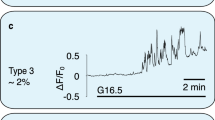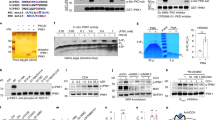Abstract
IN many cell types, receptor activation of phosphoinositidase C results in an initial release of intracellular Ca2+ stores followed by sustained Ca2+ entry across the plasma membrane. Inositol 1,4,5-trisphosphate is the mediator of the initial Ca2+ release1, although its role in the mechanism underlying Ca2+ entry remains controversial1–6. We have now used two techniques to introduce inositol phosphates into mouse lacrimal acinar cells and measure their effects on Ca2+ entry: microinjection into cells loaded with Fura-2, a fluorescent dye which allows the measurement of intra-cellular free calcium concentration by microspectrofluorimetry, and perfusion of patch clamp pipettes in the whole-cell configuration while monitoring the activity of Ca2+-activated K+ channels as an indicator of intracellular Ca2+. We report here that inositol 1,4,5-trisphosphate serves as a signal that is both necessary and sufficient for receptor activation of Ca2+ entry across the plasma membrane in these cells.
This is a preview of subscription content, access via your institution
Access options
Subscribe to this journal
Receive 51 print issues and online access
$199.00 per year
only $3.90 per issue
Buy this article
- Purchase on Springer Link
- Instant access to full article PDF
Prices may be subject to local taxes which are calculated during checkout
Similar content being viewed by others
References
Berridge, M. J. & Irvine, R. F. Nature 341, 197–205 (1989).
Putney, J. W. Jr Cell Calcium 7, 1–12 (1986).
Putney, J. W. Jr Cell Calcium 11, 611–624 (1990).
Irvine, R. F. FEBS lett. 263, 5–9 (1990).
Irvine, R. F. Biochem Soc. Trans. 17, 6–9 (1989).
Matthews, G., Neher, E. & Penner, R. J. Physiol., Lond. 418, 105–130 (1989).
Hill, T. D., Berggren, P.-O. & Boynton, A. L. Biochem. biophys. Res. Commun. 149, 897–901 (1987).
Thastrup, O. et al. Agents & Actions 27, 17–23 (1989).
Kwan, C. Y., Takemura, H., Obie, J. F., Thastrup, O. & Putney, J. W. Jr Am. J. Physiol. 258, C1006–C1015 (1990).
Morris, A. P., Gallacher, D. V., Irvine, R. F. & Petersen, O. H. Nature 330, 653–655 (1987).
Changya, L., Gallacher, D. V., Irvine, R. F., Potter, B. V. L. & Petersen, O. H. J. Membrane Biol. 109, 85–93 (1989).
Changya, L., Gallacher, D. V., Irvine, R. F. & Petersen, O. H. FEBS Lett. 251, 43–48 (1989).
Snyder, P. M., Krause, K.-H. & Welsh, M. J. J. biol. Chem. 263, 11048–11051 (1988).
Yamaguchi, K., Hirata, M. & Kuriyama, H. Biochem. J. 251, 129–134 (1988).
Llano, I., Marty, A. & Tanguy, J. Pflugers Arch. 409, 499–506 (1987).
Ryu, S. H., Lee, S. Y., Lee, K.-Y. & Rhee, S. G. FASEB J. 1, 388–393 (1987).
Irvine, R. F. & Moor, R. M. Biochem. J. 240, 917–920 (1986).
Morris, A. J., Murray, K. J., England, P. J. & Downes, C. P. Biochem. J. 251, 157–163 (1988).
Hill, T. D., Dean, N. M. & Boynton, A. L. Science 242, 1176–1178 (1988).
Irvine, R. F., Brown, K. D. & Berridge, M. J. Biochem. J. 221, 269–272 (1984).
Spat, A., Bradford, P. G., McKinney, J. S., Rubin, R. P. & Putney, J. W. Jr Nature 319, 514–516 (1986).
Parod, R. J. & Putney, J. W. Jr J. Physiol., Lond. 281, 371–381 (1978).
Parod, R. J., Leslie, B. A. & Putney, J. W. Jr Am. J Physiol. 239, G99–105 (1980).
Burgess, G. M., Bird, G. St J., Obie, J. F. & Putney, J. W. Jr J. biol. Chem. (in the press).
Grynkiewicz, G., Poenie, M. & Tsien, R. Y. J. biol. Chem. 260, 3440–3450 (1986).
Hamill, O. P., Marty, A., Neher, E., Sakmann, B. & Sigworth, F. J. Pflugers Arch. 391, 85–100 (1981).
Tang, J. M., Wang, J., Quandt, F. N. & Eisenberg, R. S. Pflugers Arch. 416, 347–350 (1990).
Dean, N. M. & Moyer, J. D. Biochem. J. 242, 361–366 (1987).
Hughes, A. R., Takemura, H. & Putney, J. W. Jr J. biol. Chem. 263, 10314–10319 (1988).
Shears, S. B., Evans, W. H., Kirk, C. J. & Michell, R. H. Biochem. J. 256, 363–369 (1988).
Stephens, L. R., Hawkins, P. T. & Downes, C. P. Biochem. J. 262, 727–737 (1989).
Kennedy, E. D., Challis, R. A. J. & Nahorski, S. R. J. Neurochem. 53, 1652–1655 (1989).
Author information
Authors and Affiliations
Rights and permissions
About this article
Cite this article
Bird, G., Rossier, M., Hughes, A. et al. Activation of Ca2+ entry into acinar cells by a non-phosphorylatable inositol trisphosphate. Nature 352, 162–165 (1991). https://doi.org/10.1038/352162a0
Received:
Accepted:
Issue Date:
DOI: https://doi.org/10.1038/352162a0
This article is cited by
-
MPP+ decreases store-operated calcium entry and TRPC1 expression in Mesenchymal Stem Cell derived dopaminergic neurons
Scientific Reports (2018)
-
The Physiological Function of Store-operated Calcium Entry
Neurochemical Research (2011)
-
Back in the water: the return of the inositol phosphates
Nature Reviews Molecular Cell Biology (2001)
-
InsP4 facilitates store-operated calcium influx by inhibition of InsP3 5-phosphatase
Nature (2000)
-
Evidence for vacuolar-type proton pumps in nonmitochondrial and inositol 1,4,5- trisphosphate-sensitive calcium stores of insulin-secreting cells
Pflügers Archiv - European Journal of Physiology (1996)
Comments
By submitting a comment you agree to abide by our Terms and Community Guidelines. If you find something abusive or that does not comply with our terms or guidelines please flag it as inappropriate.



